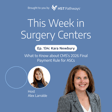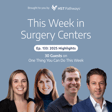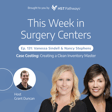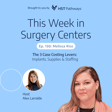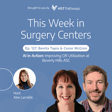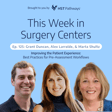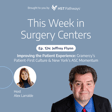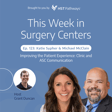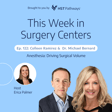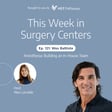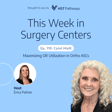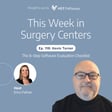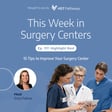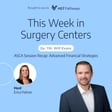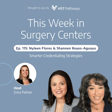Podcast Introduction
00:00:01
Speaker
Welcome to This Week in Surgery Centers. If you're in the ASC industry, then you're in the right place. Every week, we'll start the episode off by sharing an interesting conversation we had with our featured guests, and then we'll close the episode by recapping the latest news impacting surgery centers. We're excited to share with you what we have, so let's get started and see what the industry's been up to.
Interoperability in Healthcare
00:00:27
Speaker
Hi everyone, here's what you can expect on today's episode. We hear about the concept of interoperability all the time, but what does it really mean and look like in practice?
00:00:39
Speaker
Michael Powers is the administrator at Children's West Surgery Center, and he's also the president of the Tennessee Ambulatory Surgery Center Association. And he's here today to talk about the power of interoperability and technology. Michael and his team have recently undergone an initiative to transition from five or so different software vendors to one. So he shares what that process has been like and what it means for the future of his surgery center.
00:01:07
Speaker
In our news recap, we'll cover what Gen Z is looking for in a workplace and a job, the latest on cybersecurity attacks in the healthcare industry, sustainability tips for the OR, and of course, end the new segment with a positive story about a new training module built to enhance care for the homeless. Hope everyone enjoys the episode and here's what's going on this week in Surgery Centers.
Michael Powers' Background
00:01:37
Speaker
Hi, Michael. Thanks for joining us on the podcast today. Good morning, Erica. It's my pleasure to be here. Before we get into our topic, can you share a little bit about yourself with our listeners? Sure. I've been in healthcare for 38 years. I started out many years ago as a respiratory therapist, proceeded to get my graduate degree and an MBA. I've mostly been in large healthcare systems, but for the last 10 years,
00:02:05
Speaker
I have been an administrator for a multi-specialty children's pediatric ambulatory surgery center in Knoxville, Tennessee, and have had the pleasure of being on the board of our Tennessee association as well as the current president for TASCA. Awesome. That's great.
Pediatric Surgery Approaches
00:02:27
Speaker
What type of procedures do you perform and how many cases do you typically see in a month?
00:02:34
Speaker
We're averaging between 400 and 500 cases a month, so we're quite busy. When you think about the pediatric population, a lot of what we do is ear, nose, and throat, followed by urology, followed by ophthalmology, followed by oral surgery, dental, and very few orthopedics and very few plastics. Yeah. Do you find that
00:03:03
Speaker
serving a younger population is different in nature than serving an adult population? It's extremely different. You don't have the adult population having such a high anxiety that
00:03:19
Speaker
you know, that they cry, that they have separation anxiety from their mom and dad. And so we try from the very beginning have created an atmosphere, not only a physical environment where it's bright colors and we have special toys and iPads and
00:03:39
Speaker
other things to try to distract them. The other thing that we do, you know, they do receive some medication in the holding room prior to going back to the OR room to help them calm, to help the separation anxiety less and a smooth transition into the operating room. And then obviously every patient is important and you never ever want to cause harm. But we just feel this more
00:04:11
Speaker
strongly that when you're dealing with children, the bar is raised even higher for us.
Children's Recovery Process
00:04:18
Speaker
And so making sure that every eye is dotted and every T is crossed and the team's well communicated, that we're very blessed. I mean, our anesthesiologists are all boarded in the pediatrics. Our nurses, the majority of them have been with pediatrics for a very, very long time.
00:04:38
Speaker
We also have been very blessed. We have extremely low turnover. And so people know what they do and they do it very, very well. We also have a process that I think works extremely well is, you know, you have two phases of recovery. So you have your post anesthesia recovery when they're still really, really sleepy and they're starting to wake up. And in the pediatric world, it's a one-to-one.
00:05:06
Speaker
You have one nurse for one patient throughout the entire process.
Specialized Pediatric Care
00:05:10
Speaker
And then whenever they are starting to become alert and waking up, then we immediately get them into a private room in a second phase recovery with their parents, which seems to really have a smooth transition and more comforting for the child. They have their mom or dad with them and holding them and comforting them until they're ready for this turn.
00:05:32
Speaker
Yeah, yeah, and kind of waking up and seeing that familiar face I would imagine makes a huge difference. So yeah, it's just interesting because I feel like we're always kind of talking about and thinking about surgery centers from a sense where they're serving adults and the elderly population. You kind of forget that there's a lot of children that have surgeries as well.
00:05:53
Speaker
That's good. It sounds like you guys have a ton of compassion and kind of take all of that into consideration.
Software Transition for Efficiency
00:06:01
Speaker
So I was reading Becker's a few weeks ago and you caught my eye because you were featured as the administrator of the week.
00:06:09
Speaker
And as I kept reading, I learned how you were implementing new technology at your center in the hopes of greater interoperability, which is something we really haven't talked too much on the podcast yet. What is it like actually cutting out all the different siloed technologies that a lot of surgery centers use today? What were you experiencing at your facility that really drove you to want to make a change?
00:06:36
Speaker
You know, in going back to my hospital days, you know, you have you large systems, whether it be Cerner or Epic or, you know, some of the major ones that people really familiar with, and they were really focused on which 80, 90% of what a lot of the patient population coming through is in-patients, right? And then you see the growth in the outpatient world, but mainly,
00:07:03
Speaker
It can be PT or whatever, so their needs are different.
Tech Integration Challenges
00:07:10
Speaker
I have never really seen in my past year, especially on the hospital side, that these large software companies really had a focus or a really great product for outpatient surgery.
00:07:23
Speaker
So being in this facility, whenever I started working here 10 years ago, they were using a product that they started with, and this center is now this month actually celebrating its 20th anniversary for 20 years. Nice. Thank you. And in that 20 years, we have served over 80,000 patients. And so we're going to celebrate later this month.
00:07:51
Speaker
What I discovered coming here is so you had this business software that was able to do obviously your registration, your OR scheduling, your billing, keeping up with that, your accounts, posting for your accounts for the patient billing population. But that was pretty much all that it did. The other piece was
00:08:21
Speaker
You know, you were only allowed a, so many number of people that you paid for to have access to the system. And as we've been growing, it was being very common that we would say, Oh, do you need this product? Can I have it for a few minutes? You know, while I need to look something up. And so we were having to share. And when we looked at adding more users, it just was not cost-effective. It did not make sense.
00:08:51
Speaker
and this product being as the age that it was they were maintaining it to function and it functioned very well from a stability standpoint but there was no upgrades, no changes, etc. So we ended up really having paper charts having this one old system to cover those functions that I mentioned
00:09:17
Speaker
to me saying how can we try to eliminate some of the manual work that we're doing to more of utilizing either a social media or other kinds of software applications to better communicate with our patients and families and to be more efficient.
00:09:42
Speaker
And so the next thing we added was we added an online pre-admission medical questionnaire instead of calling every single patient. And we were calling them and trying to get mom or dad on the phone and trying to ask them this long questions. And either A, they went answer B, it would go to voicemail or C, the voicemail wasn't set up.
00:10:06
Speaker
And you were just, or sometimes you call mom and she's in a grocery store, you know, pushing a buggy in and with the kid and just wasn't convenient to answer all these questions. And so there's a lot of callbacks, callbacks, callbacks. So creating this, uh, working with this system of where we could just send out to mom and dad. And we originally did it from the physician's office in a brochure.
00:10:32
Speaker
to say, here, go online, here's the link, go fill out this medical questionnaire and answer it, and you can do it at your convenience. And then we monitored, and our goal was seven calendar days or five business days prior to the date of surgery that they would have that completed. If not, then we were prompting them that they really needed to get that completed. Because as you know, in an ambulatory surgery center,
00:11:00
Speaker
if they have any kind of complications, comorbidities or whatever, they're not a candidate to come. And we're blessed that we have a children's hospital right here in town that they would go there if they needed to have the procedure done. And so that was the first thing we did. And it was, I mean, huge in the amount of work that it took off of our pre-admission nursing staff.
00:11:25
Speaker
And then the next step we went to was getting another separate texting platform that we began to text patients.
00:11:39
Speaker
And so we get texts from them if we need them to contact the business office for discussed deductibles or out-of-pocket expenses. The pre-admission nurse could text that they had questions and needed, you know, once they reviewed their medical questionnaire. And then we always, the day before surgery, because you're always having additions, subtractions, cancellations. So the day before surgery is when we really put all of our patients in order
00:12:09
Speaker
when they're coming, how we're gonna do our day to make it most efficient as possible so the day before surgery, then we're texting NPO instructions, which they've already had in writing before, as well as their arrival times to the center. Now obviously on the front end we get permission to text them and they give us either opt in or opt out.
Staff Adaptation to New Systems
00:12:33
Speaker
And then lastly is we were doing not electronic charting but paper charting
00:12:39
Speaker
And at the end of the day, when a patient was discharged, then all those charges were being scanned into a another software that was a digital repository for all of our records. Then we could shred the paper and then everybody, you know, can have access if they needed to see an old record to anyone. So even though we had continued.
00:13:03
Speaker
to advance utilization of what technology offers us today. You had four, five, six different vendors and applications and software, and not everybody was talking to one another. And seeing that our core business office software system
00:13:31
Speaker
was aging and getting older and there was no upgrades or whatever, to me the writing was on the law that eventually this was going to be phased out. So we began actually a year ago thinking
00:13:47
Speaker
doing research, talking to a lot of my colleagues to see what they're using, where they're at, and then doing demos and asking a lot of questions and seeing things. And we even went to some local facilities, ASC, friends of mine, to look at products that they had and were using to help us narrow down what we thought would be the best product for us that will allow us over time, not only improve day one,
00:14:18
Speaker
but slowly phase in these other things so that we can have one vendor, if you will, one application that house all of this for us. And think about staff. They wouldn't need six or seven different passwords. They have to learn five or six different systems that it can all be housed.
00:14:40
Speaker
within one. So having that long-term goal and living in that world brought us to, as I stated, you know, when I was talking to backers of really focusing on not just where do we want to go this year, but where we see ourself in three years and five years and finding a vendor that we believed would have that flexibility to grow with us. Yeah, absolutely.
00:15:09
Speaker
And I think that's the only path forward, right? Especially when you talk three years, five years with all the different outcomes that are coming and all the different reporting and measures. It's like you have to have these systems that speak to one another so that when it's time to pull these reports and metrics and
00:15:26
Speaker
and plan for the future, you have the data and the systems that speak to one another so that you're able to do so. So you knew you had to make a change. How did you start socializing that with your staff to get all of them on board, or were they just so frustrated with the day-to-day that they were welcoming change? It was mixed. Some were welcoming the change because they could see
00:15:53
Speaker
you know, some of the frustrations that we had with the existing system, especially not enough access for users. And, you know, the new systems is unlimited users. I mean, and so, I mean, that right there seemed small, but it was a big, big deal. Your people who I think use this more than anyone else, especially initially is your business office.
00:16:20
Speaker
They're doing the registration. They're doing the OR schedules. They're doing the billing. They're doing the posting. They're doing the communication. They're making sure the emails, the cell and phone numbers, all this data and everything upfront is accurate. They're doing the insurance verification and benefits, which I didn't even talk about that. Our old system was they would have to go on the website.
00:16:45
Speaker
look at that individual person, find out, you know, what their benefits were and create this manual sheet on, you know, where they were in their deductible, what we were having done, what was the, you know, the allowable based upon our contract rate, where now we'll be able to do that, you know, just by simply through the system. So again, highly effective, highly efficient, a lot less manual labor on the individuals. But I think
00:17:15
Speaker
just encouraging people that we believe that it's either gonna be now or it's gonna be in a near future, we're gonna make a change. And so let's be proactive and let's do it. And I think also they trusted us that we did our homework, we took our time, we did our due diligence.
00:17:40
Speaker
And then the other two things we did is we took some of our key staff to some local facilities that was using the product that we felt like was the one that we wanted to go with so that they could see it. And then lastly is I spent a lot of energy and time and I wouldn't say go on an overboard, but I made sure that they had a lot of hands-on training
00:18:08
Speaker
and accessibility during that whole process of leading up to and the first couple of days of Go Live were that, you know, they were never in a secret swim situation. Sure.
Patient Experience Improvements
00:18:24
Speaker
So, and that makes sense how, so I'm getting how, you know, true interoperability will impact your staff day to day. What about from the patient side? How do you think they are impacted by having this technology and in all of your systems speaking to one another? I think it's not going to be as visible to them because
00:18:49
Speaker
You know, we still text them, that's going to be the same. The questions that we asked them, that's all going to be the same. So all the pre-work is going to be the same. How we handle them from a patient care perspective internally is going to be the same. I think the only thing that we haven't done yet, it's in the future.
00:19:12
Speaker
is with the system that we have, we'll be able that we can set up an OR board where they will be able to visually know their child's in the OR, their child's in recovery, and we'll be able to have a visual communication that today they don't have.
00:19:29
Speaker
It's more of, you know, we will let them know verbally, especially if it's a long case, how things are going and we'll talk to them via phone. But I think that's something new in the future that will help them. But again, thinking about our patient population and the families, I think since we didn't add anything new to them, then it's pretty seamless for the patient and family side.
00:19:58
Speaker
Sure, definitely. Makes sense.
Efficiencies Post-Implementation
00:20:01
Speaker
And since you've kind of started down this journey, have you seen any immediate benefits or direct time savings, direct financial savings that you can report on? I know it hasn't been too long, but. Um, initially financial savings, I'm going to say no. Um, uh, but efficiency and staff satisfaction. Absolutely. So.
00:20:27
Speaker
Efficiency part is we have actually decreased from an average of eight minutes to five minutes for registering patients, which shocked me. We did that within two or three weeks. The other thing is that, like I said, it's small, but we have unlimited users that can access the system. So no more of, like I said, asking someone, hey, can you get off so I can get on to look and do something?
00:20:55
Speaker
and then I'll give it back to you. I mean, we don't have that anymore. And then it's just very more up to date, in fact, of being very intuitive on how you maneuver. If you're used to using Google, if you're used to using a computer, then it is more up to date. And being able to put patient on the OR schedule, being able to rearrange that is so much easier than the older system.
00:21:25
Speaker
Um, so I think efficiencies just in the use of it, uh, efficiencies in its design, um, efficiencies in, uh, it's anybody can access it. Um, and we've been able to, I think in those ways, um, utilizing the testing system and all the patients that we register.
00:21:51
Speaker
are already automatically in the texting system, so we just pull up the patient, right there's their cell number. We can text them whatever we want to. Obviously, we have templated formatted texts that are common just by everybody, but we also can make it unique based upon anything special that we need to communicate to them.
00:22:15
Speaker
We're in the final phases of bringing up the insurance verification piece to go online. We've had to do a little bit of integration with that.
00:22:31
Speaker
It's definitely people, once they started to see it and once they started to get where we were going and its capabilities, then it just built excitement. It built among the staff and I think that became just
00:22:52
Speaker
was shared and as one person got excited, then another person see that excitement and then they would start getting excited and it sort of spread in a very positive way. Yeah. Yeah, that's great. Okay. I think that was all the questions we had today, but we do this every week with our guests.
Enhancing Surgery Centers
00:23:13
Speaker
What is one thing our listeners can do this week to improve their surgery centers?
00:23:22
Speaker
I think that for me is number one is for us, the focus, it's hard to find staff. Staffing shortages is a big deal. So ensuring that you're competitive on compensation for 1K matching.
00:23:46
Speaker
You know, things that you can do, you can do small things. Just last week, we brought in a coffee truck and paid for everybody to get a coffee or a hot chocolate or whatever, just to sort of celebrate some of the things that we've accomplished. I think from an administrator side to a surgery center side, obviously, if you want to be extremely successful, work in your OR schedule.
00:24:14
Speaker
knowing what your most profitable cases are, maximizing that, knowing your fastest positions, giving them two rooms to flip back and forth, working the OR schedule and such that you're doing cases that make you the most money, that you don't have gaps, and that you're doing as many cases that you can per day. I think that's foundational. Number two,
00:24:40
Speaker
is we work and we rework every three years, every contract that we have to get fee increases. So I think staying on top of that and again, you got to know your business. And if you don't know what your most profitable and your most common cases are, then you have to very closely watch the contracts you negotiate because they sort of want to stay budget neutral.
00:25:09
Speaker
But what you want is you want the cases that you do the most of to make the highest profit off of. So having that data and knowing your business. And then lastly is everything that you can to control your expenses. So I mean, you know, the bottom line is you got to have happy employees. Happy employees will make happy physicians and happy patients. And then if you want to be profitable,
00:25:39
Speaker
is knowing your business, working your OR schedule, increasing your revenues, and decreasing your expenses. I mean, it's basically what I call your very basics in football of just blocking and tackling really well every day in and out. And I think staying connected through your associations, through your state or the national associations, having other administrators or other individuals that you network with and talk with,
00:26:09
Speaker
I find very invaluable.
00:26:12
Speaker
Yeah, I agree. And I think HST works closely with a lot of the associations. We love working with Tennessee and it's amazing how much the associations do at the state level on behalf of their members and all surgery centers. It's really impressive. So kudos to you. All right, Michael, thank you so much. I appreciate all your time and expertise and can't wait to see what the future holds for you guys.
00:26:40
Speaker
Thank you, it's my pleasure and you have a wonderful day. You too, thank you.
Gen Z in Healthcare Workforce
00:26:50
Speaker
As always, it has been a busy week in healthcare, so let's jump right in.
00:26:55
Speaker
LinkedIn recently published their 2023 Workplace Learning Report and revealed that members of Gen Z, which is defined by the US Census as those born between 1997 and 2013, prioritize job security, competitive pay, and a good work-life balance when considering job opportunities.
00:27:17
Speaker
They also value workplace diversity and inclusivity, prefer clear communication and feedback, and value company transparency and social responsibility. So why does this matter? The average age of a nurse in the US right now is 52. So as more of our experienced nurses are looking to retire,
00:27:41
Speaker
or maybe even just pick up less shifts, surgery centers and other healthcare facilities need to understand how to attract and retain younger nurses and leaders. And as Gen Zers are now either fully part of the workforce or are just considering what their career might be, employers need to focus on providing these key elements in their workplace culture
00:28:02
Speaker
So that younger staff and those just coming out of college or those who are working looking for a career will consider working at their surgery centers or health care facilities. So I highly recommend checking out the article and the full report. We will link both in the episode show notes so you can easily find them.
Cybersecurity in Healthcare
00:28:23
Speaker
A recent report by Moody's Investor Service highlights the increasing importance of cybersecurity investments for health care organizations.
00:28:32
Speaker
So this topic is nothing new. And the report notes, as we all know, that healthcare orgs are particularly vulnerable to cyber attacks due to the large amounts of sensitive patient data that they naturally handle and store. And a cyber attack will not only cause financial loss, but will also cause reputational damage and legal liabilities. So for perspective,
00:28:56
Speaker
Federal records indicate that healthcare breaches have exposed 385 million patient records from 2010 to 2022, and that 89% of healthcare providers
00:29:09
Speaker
typically suffer a cyber attack over any given 12-month timeframe. So the good news is that the report found that healthcare organizations are increasing their investments in cybersecurity measures, such as data encryption, employee training, and software and hardware updates. And that is becoming more common that these healthcare orgs are outsourcing their cybersecurity functions to third-party vendors that specialize in this area.
00:29:37
Speaker
One interesting call out that I thought was important was that investors are increasingly asking healthcare organizations about their cybersecurity strategies. So previously, maybe it was something they asked, but it didn't hold as much weight as it does today. And also investors will be less likely to put money into organizations that do not have strong cybersecurity measures in place.
00:30:01
Speaker
Um, so we have reported on stories like this before and will continue to do so. Um, as this is one area that unfortunately you can't just get away with the set it and forget it mindset. Um, and you must stay on top of it as things are constantly evolving.
Sustainability in Healthcare
00:30:20
Speaker
In our third story from Outpatient Surgery magazine, they are highlighting the environmental impact of healthcare operations and the potential benefits of practicing more sustainability. So every healthcare facility contributes significantly to environmental pollution and waste.
00:30:39
Speaker
This includes greenhouse gas emissions, waste generation, water usage, single-use medical devices, packaging materials, and the list goes on and on. But one specific call-out in this article is gloves.
00:30:54
Speaker
The article states that if you're serious about sustainability, you better be focusing on your glove purchasing practices. So why call out this single item? According to a senior strategist at Healthcare Without Harm, they're one of the highest volume products in healthcare. They have significant resource in greenhouse gas use associated with them. They naturally generate large amounts of waste
00:31:22
Speaker
They contain chemicals that are concerning and have a problematic supply chain. So it is a bad day to be a glove. And I think gloves in general might need a PR team after this article. But everything that they shared really does make sense. But the good news is that Healthcare Without Harm did release a step-by-step guide called New Sustainability Criteria for Examination in Surgical Gloves.
00:31:48
Speaker
They lay out exactly what you should be looking for in your vendors. What example would be, what's going on with their packaging processes? Are they sustainable? Is everything recyclable? Are they only using materials that are necessary? No extra fluff, stuff like that.
00:32:11
Speaker
So overall, this article serves as a reminder of the importance of sustainability practices in perioperative settings. And I do encourage every surgery center to adopt environmentally sustainable practices in their operations wherever they can. And we also have a great podcast episode we did with Adam Hornback on real ways to reduce waste and increase recycling that came out in December 2022, if you are interested in learning more about this topic.
Homeless Care Training Module
00:32:43
Speaker
And to end our new segment on a positive note, Yasmine Latour, an assistant professor at Villanova University College of Nursing, has developed a training module for healthcare providers to enhance care for the homeless. The module aims to increase knowledge and awareness of the unique health needs and challenges faced by homeless individuals and provide strategies for effective communication and empathy.
00:33:10
Speaker
The program has been tested in Philadelphia so far and has received positive feedback from healthcare providers who reported feeling more confident and prepared to provide care to homeless patients. And the goal is that this module can be implemented in healthcare facilities across the country to improve healthcare for the homeless population.
00:33:31
Speaker
And that news story officially wraps up this week's podcast. Thank you as always for spending a few minutes of your week with us. Make sure to subscribe or leave a review on whichever platform you're listening from. I hope you have a great day and we'll see you again next week.

